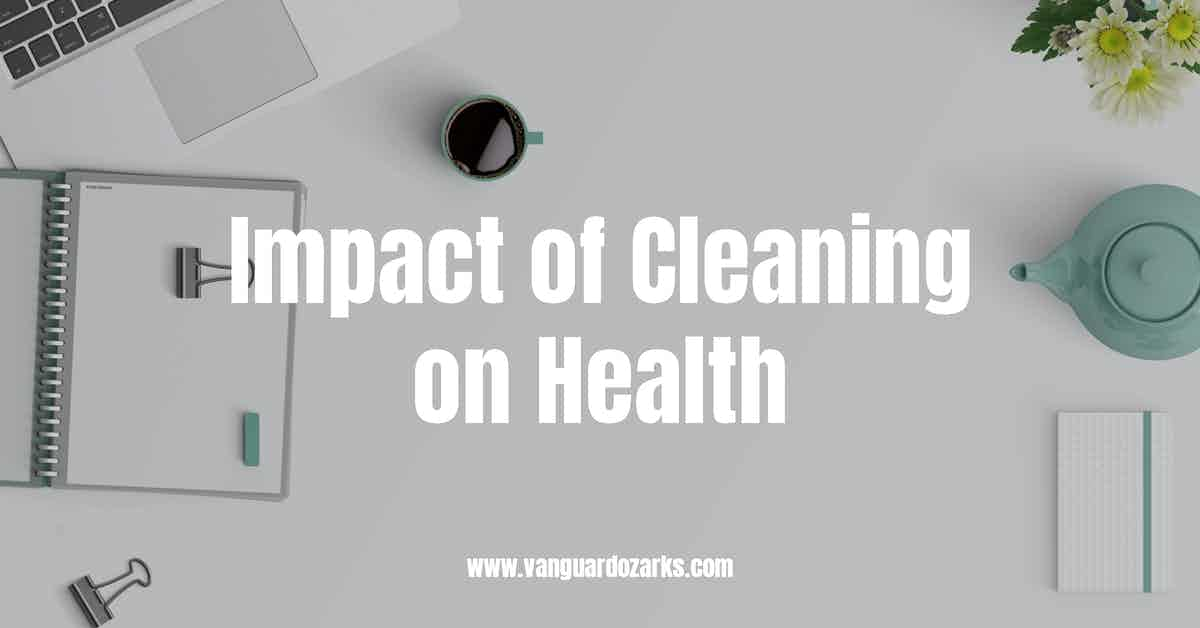A clean workspace has a proven positive impact on your mental and physical health and wellness, but the products that are used are equally, if not more, essential to your long-term wellbeing.

The Impact of Cleaning on Your Physical and Mental Health
The majority of Americans spend most of their time indoors, where the cleanliness of the environment and the air has a direct impact on their mental and physical health.
Research has shown that, despite the necessary appearance of tidiness and cleanliness for our mental wellbeing, the toxicity of the products used in the cleaning process can have serious adverse effects on our physical health.
The two demographics who spend the most time indoors--the elderly and the very young--are also the most vulnerable to the negative side-effects of improper cleaning practices, poor indoor environment quality, inadequate ventilation, and high levels of indoor air pollution.
During the warmer part of the year, the issue is often exacerbated for several reasons, including:
- A reduction in outdoor airflow (closed windows and doors) due to increased heat.
- An increase in external air pollution due to increased travel.
- Spikes in exposure to chemical pollutants, especially pesticides, and;
- Overexposure to commercial disinfectants, especially in poorly ventilated facilities--older offices, classrooms, gyms, and churches.
While cleaning, as mentioned, is necessary to the mental health and wellbeing of facility occupants, and the products used in the cleaning process are often essential, regardless of toxicity, to combat deadly pathogens, such as SARS-CoV-2, the method employed to sanitize the facility can significantly reduce symptoms commonly experienced by facility occupants in buildings that lack well-designed cleaning policies and air quality controls, such as:
- Irritation of the eyes, nose, and throat.
- Headaches, dizziness, and fatigue.
- Respiratory diseases, heart disease, and cancer.
The Relationship Between Cleanliness, Clutter, and Mental Health
Whether inside or out, a person's environment has a direct impact on their mental health and stress levels.
Dirty, cluttered environments increase stress, confusion, and tension while decreasing focus, cognitive functions, and productivity and may contribute to or increase the likelihood of depression.
According to Verywell Mind;
To the brain, clutter represents unfinished business and this lack of completeness can be highly stressful for some people.
This fact is especially true when people have significant concerns pressing in on their lives.
Organizations that focus on cleaning for occupant health see a marked increase in worker happiness and corresponding productivity.
According to Facility Executive;
In addition to boosting productivity, cleanliness can result in heightened overall workplace satisfaction and a stronger culture.
No one wants to work in a dirty office environment.
In fact, according to the 2017 Healthy Hand Washing Survey, 89 percent of Americans believe the condition of a workplace restroom is one indicator of how a company values its workforce.
Plus, there’s an added bonus of happier employees.
A 2015 study found that they are 12 percent more productive, while unhappy employees are 10 percent less productive.
Hazardous Substances in Commonly Used Cleaning Products
Commercial cleaning is, unfortunately a bit of a double-edged sword.
A clean, hygienic facility is mandatory for occupant health, but the products needed to kill dangerous and often deadly germs and bacteria can be equally problematic.
According to a recent study published by the American Journal of Respiratory and Critical Care Medicine;
Cleaning tasks may imply exposure to chemical agents with potentially harmful effects to the respiratory system, and increased risk of asthma and respiratory symptoms among professional cleaners and in persons cleaning at home has been reported.
Long-term consequences of cleaning agents on respiratory health are, however, not well described.
Women cleaning at home or working as occupational cleaners had an accelerated decline in lung function, suggesting that exposures related to cleaning activities may constitute a risk to long-term respiratory health.
Cleaning at Home and at Work in Relation to Lung Function Decline and Airway Obstruction
Additionally, according to the results of a study published by the National Institutes of Health;
Cleaning products potentially give rise to simultaneous exposures to different chemical substances.
As professional cleaners represent a large workforce, and cleaning products are widely used, it is a major public health issue to better understand these exposures.
Hazardous substances in frequently used professional cleaning products
Addressing the Challenges of Safely and Effectively Cleaning Facilities
Cleaning safely while effectively combatting deadly outbreaks and the presence of dangerous microbes is a challenge requiring a multi-pronged approach by stakeholders at every level.
Custodial teams must be trained and equipped with sufficient tools, detergents, and disinfectants to rid a building of the dangers that lurk on nearly every surface.
Additionally, each team member must wear appropriate protective equipment, including respirators, gloves, goggles, and potentially full-body suits to avoid inhaling or directly exposing themselves to toxic chemicals, especially in facilities with inadequate ventilation.
Facility executives must strive to ensure that HVAC and mechanical ventilation systems provide sufficient airflow to disperse harmful volatile organic compounds in the air that harm custodial workers and occupants.
Students, workers, and other denizens must communicate suspected health and safety issues to building executives immediately and remove themselves from any area they suspect of representing a hazard to their health.
Additional recommendations include:
- Using Safer Choice cleaners as practical, and less toxic chemicals.
- Implementing targeted disinfection procedures that focus on high-contact surfaces.
- Scheduling cleaning and disinfection services during times when a building has little to no occupancy, and;
- Ensuring all health and safety recommendations from product manufacturers are adhered to.
References & Resources
Takeaway
Commercial cleaning is a necessary service that ensures public health and safety while contributing to the mental wellbeing of facility occupants.
However, it is not without its dangers and challenges.
Commonly used commercial disinfectants, such as chlorine-based bleach and quats, have been linked to serious health issues in both custodial workers and facility occupants due to unsafe levels of exposure.
Given the importance of cleaning combined with the dangers posed by the process and products, only trained professionals should handle many products that are unfortunately likely seen as commonplace in many facilities.
Outsourcing is a proven method for onboarding the necessary labor resources required to safely and effectively sanitize your facility while protecting occupant physical and mental health and safety.
Contact us today and discover why Vanguard Cleaning Systems® is the Standard of Clean® for businesses throughout Northwest Arkansas, Missouri, and Oklahoma.
In Oklahoma, dial 918-960-4450
In Arkansas, dial 479-717-2410
In Missouri, dial 417-812-9777

